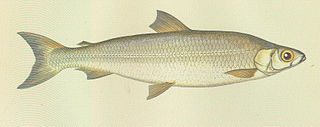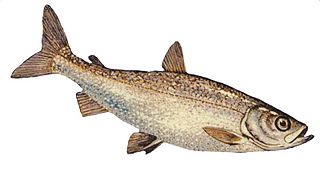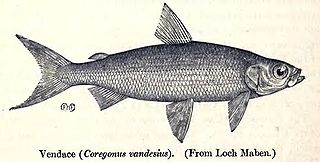
Coregonus lavaretus is a species of freshwater whitefish, in the family Salmonidae. It is the type species of its genus Coregonus.

The gwyniad is a freshwater whitefish native to Bala Lake in northern Wales.

The shortnose cisco is a North American freshwater whitefish in the salmon family Salmonidae. One of the members of the broader Coregonus artedi species complex of ciscoes, it is native to the Great Lakes of Canada and the United States. Its population has been declining and it has disappeared from some of its earlier haunts. The last reported population was restricted to Georgian Bay off Lake Huron in Canada. It is thought that declines in the population of this fish may be linked with the arrival of the sea lamprey, in the Great Lakes. The International Union for Conservation of Nature has rated the conservation status of this fish as "critically endangered", and possibly extinct.

The pollan or Irish pollan is a freshwater whitefish known only from five Irish lakes, Lough Neagh, Lower Lough Erne, Lough Ree, Lough Derg, and Lough Allen. The Irish pollan faces competition from introduced species such as pike, roach, and zebra mussel and the populations rely on restocking for survival.
The blackfin cisco was a North American salmonid fish in the freshwater whitefish sub-family Coregoninae. This silvery, deep-bodied fish with black fins, large eyes, a blunt snout and a terminal mouth, was one of the largest forms of ciscoes. The blackfin cisco used to inhabit the Great Lakes of North America until recently, but has been reported to have gone extinct. The blackfin cisco is a member of the C. artedi complex, whose taxonomy has not yet been resolved, and it may not represent a valid species.

Arctic cisco is an anadromous species of freshwater whitefish that inhabits the Arctic parts of Siberia, Alaska and Canada. It has a close freshwater relative in several lakes of Ireland, known as the pollan, alternatively regarded as conspecific with it, or as a distinct species.

The broad whitefish is a freshwater whitefish species. Dark silvery in colour, and like a herring in its shape, its distinctive features include a convex head, short gill rakers, and a mild overbite. It is found in the Arctic-draining streams, lakes, and rivers of far eastern Russia and North America. Its prey includes larval insects, snails, and shellfish. It is eaten by humans and brown bears.

Coregonus hoyi, also known as the bloater, is a species or form of freshwater whitefish in the family Salmonidae. It is a silvery-coloured herring-like fish, 25.5 centimetres (10.0 in) long. It is found in most of the Great Lakes and in Lake Nipigon, and inhabits underwater slopes. This fish is not to be confused with the extinct deepwater cisco, a large fish that shared a common name with the bloater.
The schelly is a living fresh water fish of the salmon family, endemic to four lakes in the Lake District, England. Its taxonomy is disputed with some recognizing it as a distinct species and others as a variant of the widespread Eurasian whitefish species Coregonus lavaretus. It is present in Brothers Water, Haweswater, Red Tarn and Ullswater, and the population seems stable in all of these except for Haweswater where it seems to be declining. The main threats it faces are seen to be water abstraction and cormorants, and the fish-eating birds are being culled from Haweswater. The International Union for Conservation of Nature has rated the conservation status of this fish as "endangered".

Coregonus vandesius, the vendace, is a freshwater whitefish found in the United Kingdom. Population surveys since the 1960s have revealed a steady decline and the fish is no longer present in some of its previous haunts but is still present in Bassenthwaite Lake and Derwent Water. The main threats it faces are eutrophication and the introduction of alien species of fish which eat its eggs and fry. The International Union for Conservation of Nature has rated its conservation status as "endangered".
Coregonus confusus is a freshwater whitefish from Switzerland. It is also known by its native Swiss German common name, spelled pfärrit, pfarrig, and pfärrig. It was described as Coregonus annectens confusus by Victor Fatio in 1885 from syntypes which have been lost in 1902. The species is rare and only known with certainty from Lake Biel. There is also a possibility that it might occur in Lake Neuchâtel. It vanished from Lake Murten in the 1960s due to eutrophication and water level management.

The humpback whitefish, also referred to as the bottom whitefish, the Arctic whitefish or the pidschian, is a species of freshwater whitefish with a northern distribution. It is one of the members in the broader common whitefish complex, or the Coregonus clupeaformis complex. This fish lives in estuaries and brackish water near river mouths, in deltas and in slowly running rivers, in large lakes with tributaries, and floodplain lakes. It can migrate long distances upriver for spawning.
Coregonus trybomi is a freshwater whitefish in the family Salmonidae. It is a spring-spawning type of cisco, which probably has evolved from sympatric vendace independently in a number of Swedish lakes. Only one of those populations survives, and it is therefore considered Critically Endangered by the IUCN Red List. The status of Coregonus trybomi as a distinct species is however questionable. By Swedish authorities it is treated as a morphotype or ecotype, not an independent species. It was listed as "Data Deficient" in 2010 but excluded from the national red list in 2015.
Coregonus albellus, also called the autumn brienzlig, is a species of whitefish belonging to the family Salmonidae. It is endemic to Lakes Thun and Brienz in Switzerland's Interlaken region, where it is pelagic in deep water. The maximum length recorded for this species is 26.0 centimetres (10.2 in).

Coregonus alpinus is a species of freshwater whitefish in the family Salmonidae. It is endemic to Lake Thun, in Switzerland's Interlaken region, where it is found in deep water. The maximum length recorded for this species is 25 centimetres (9.8 in). It feeds on chironomids and other bottom-dwelling invertebrates. It is known as the kropfer, a name also applied to the probably extinct species Coregonus restrictus.
Coregonus bezola was a species of freshwater whitefish in the family Salmonidae. It was endemic to the Lac du Bourget in Savoie, France where it was pelagic in deep water. The maximum length recorded for this species is 32.0 centimetres (12.6 in). It is known from specimens collected in the late 19th century, and was reported by fishermen to have disappeared in the 1960s. It spawned in January and February, on the muddy bottom of the lake, at a depth of 70 to 80 metres (230–260 ft).

Coregonus maraena, referred to in English as the maraene, maraena whitefish or the whitefish, is a whitefish of the family Salmonidae that occurs in the Baltic Sea basin - in the sea itself and the inflowing rivers, and in several lakes as landlocked populations. It is found in Denmark, Estonia, Finland, Germany, Latvia, Lithuania, Netherlands, Norway, Poland, Slovakia, Russia and Sweden. As of 2013, it has been listed as a vulnerable species by the IUCN and as endangered by HELCOM. It is an extremely important fish within the Baltic Sea ecosystem, both for population equilibrium and for the local diets of the surrounding human population. Due to a variety of factors, mostly overfishing, the maraena’s population dwindled to near-extinction levels. Thus, rampant repopulation was enacted to preserve this important fish.

Coregonus gutturosus, the Lake Constance whitefish, is an extinct species of whitefish in the salmon family Salmonidae. It was formerly found only in deep areas of Lake Constance in the Alps.
Coregonus restrictus is an extinct freshwater fish from the family Salmonidae. It was originally discovered in Lake Morat, Switzerland, in 1885. In 2008 it was included on the IUCN Red List by J. Freyhof and M. Kottelat. It was first described by Fatio.












